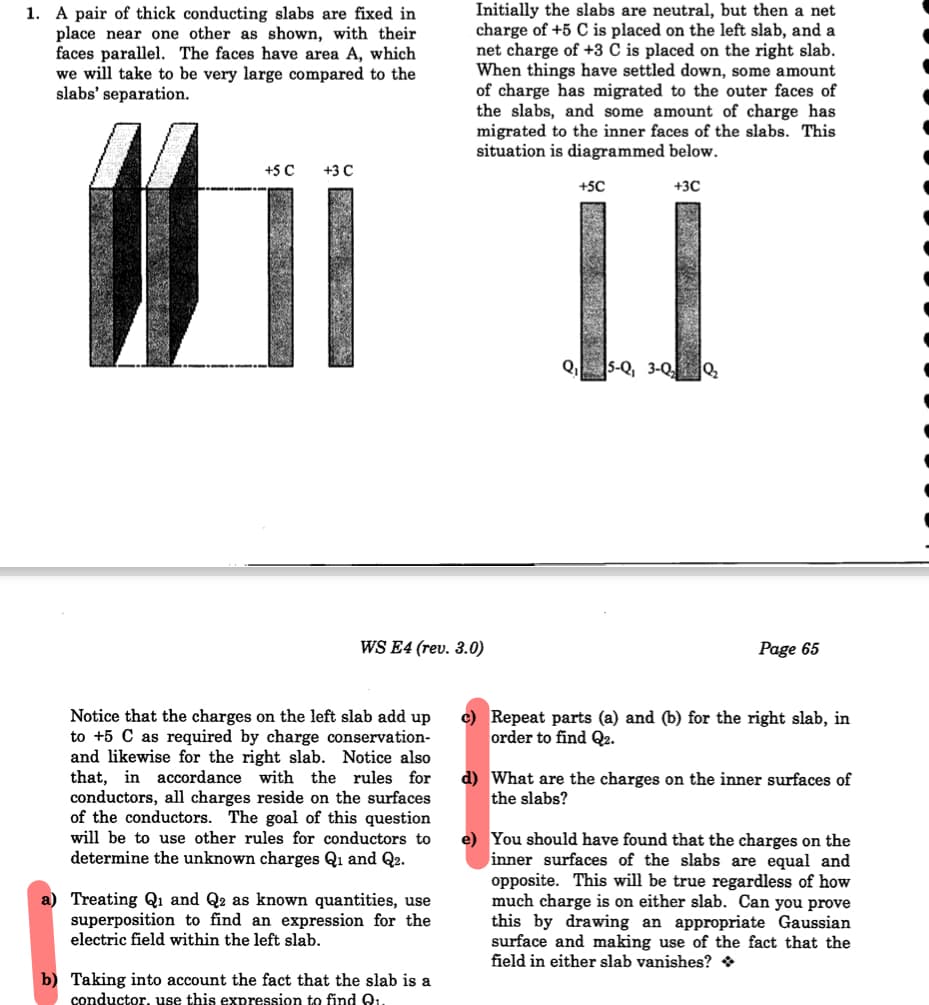d) What are the charges on the inner surfaces of the slabs? e) You should have found that the charges on the inner surfaces of the slabs are equal and opposite. This will be true regardless of how much charge is on either slab. Can you prove this by drawing an appropriate Gaussian surface and making use of the fact that the field in either slab vanishes? *
d) What are the charges on the inner surfaces of the slabs? e) You should have found that the charges on the inner surfaces of the slabs are equal and opposite. This will be true regardless of how much charge is on either slab. Can you prove this by drawing an appropriate Gaussian surface and making use of the fact that the field in either slab vanishes? *
Principles of Physics: A Calculus-Based Text
5th Edition
ISBN:9781133104261
Author:Raymond A. Serway, John W. Jewett
Publisher:Raymond A. Serway, John W. Jewett
Chapter19: Electric Forces And Electric Fields
Section: Chapter Questions
Problem 15CQ: A common demonstration involves charging a rubber balloon, which is an insulator, by rubbing it on...
Related questions
Question
Please answer d and e only

Transcribed Image Text:1. A pair of thick conducting slabs are fixed in
place near one other as shown, with their
faces parallel. The faces have area A, which
we will take to be very large compared to the
slabs' separation.
Initially the slabs are neutral, but then a net
charge of +5 C is placed on the left slab, and a
net charge of +3 C is placed on the right slab.
When things have settled down, some amount
of charge has migrated to the outer faces of
the slabs, and some amount of charge has
migrated to the inner faces of the slabs. This
situation is diagrammed below.
+5 C
+3 C
+5C
+3C
Q 5-Q, 3-Q Q
WS E4 (rev. 3.0)
Page 65
c) Repeat parts (a) and (b) for the right slab, in
order to find Q2.
Notice that the charges on the left slab add up
to +5 C as required by charge conservation-
and likewise for the right slab. Notice also
that, in accordance with the rules for
conductors, all charges reside on the surfaces
of the conductors. The goal of this question
will be to use other rules for conductors to
determine the unknown charges Q1 and Q2.
d) What are the charges on the inner surfaces of
the slabs?
e) You should have found that the charges on the
inner surfaces of the slabs are equal and
opposite. This will be true regardless of how
much charge is on either slab. Can you prove
this by drawing an appropriate Gaussian
surface and making use of the fact that the
field in either slab vanishes? *
a) Treating Qı and Q2 as known quantities, use
superposition to find an expression for the
electric field within the left slab.
b) Taking into account the fact that the slab is a
conductor, use this expression to find Q1
Expert Solution
This question has been solved!
Explore an expertly crafted, step-by-step solution for a thorough understanding of key concepts.
Step by step
Solved in 2 steps with 2 images

Knowledge Booster
Learn more about
Need a deep-dive on the concept behind this application? Look no further. Learn more about this topic, physics and related others by exploring similar questions and additional content below.Recommended textbooks for you

Principles of Physics: A Calculus-Based Text
Physics
ISBN:
9781133104261
Author:
Raymond A. Serway, John W. Jewett
Publisher:
Cengage Learning


College Physics
Physics
ISBN:
9781285737027
Author:
Raymond A. Serway, Chris Vuille
Publisher:
Cengage Learning

Principles of Physics: A Calculus-Based Text
Physics
ISBN:
9781133104261
Author:
Raymond A. Serway, John W. Jewett
Publisher:
Cengage Learning


College Physics
Physics
ISBN:
9781285737027
Author:
Raymond A. Serway, Chris Vuille
Publisher:
Cengage Learning

Physics for Scientists and Engineers
Physics
ISBN:
9781337553278
Author:
Raymond A. Serway, John W. Jewett
Publisher:
Cengage Learning

Physics for Scientists and Engineers with Modern …
Physics
ISBN:
9781337553292
Author:
Raymond A. Serway, John W. Jewett
Publisher:
Cengage Learning
